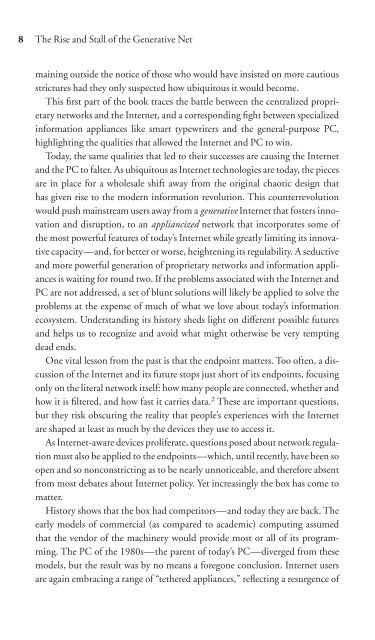Download - Future of the Internet â And how to stop it.
Download - Future of the Internet â And how to stop it.
Download - Future of the Internet â And how to stop it.
You also want an ePaper? Increase the reach of your titles
YUMPU automatically turns print PDFs into web optimized ePapers that Google loves.
8<br />
The Rise and Stall <strong>of</strong> <strong>the</strong> Generative Net<br />
maining outside <strong>the</strong> notice <strong>of</strong> those who would have insisted on more cautious<br />
strictures had <strong>the</strong>y only suspected <strong>how</strong> ubiqui<strong>to</strong>us <strong>it</strong> would become.<br />
This first part <strong>of</strong> <strong>the</strong> book traces <strong>the</strong> battle between <strong>the</strong> centralized proprietary<br />
networks and <strong>the</strong> <strong>Internet</strong>, and a corresponding fight between specialized<br />
information appliances like smart typewr<strong>it</strong>ers and <strong>the</strong> general-purpose PC,<br />
highlighting <strong>the</strong> qual<strong>it</strong>ies that allowed <strong>the</strong> <strong>Internet</strong> and PC <strong>to</strong> win.<br />
Today, <strong>the</strong> same qual<strong>it</strong>ies that led <strong>to</strong> <strong>the</strong>ir successes are causing <strong>the</strong> <strong>Internet</strong><br />
and <strong>the</strong> PC <strong>to</strong> falter. As ubiqui<strong>to</strong>us as <strong>Internet</strong> technologies are <strong>to</strong>day, <strong>the</strong> pieces<br />
are in place for a wholesale shift away from <strong>the</strong> original chaotic design that<br />
has given rise <strong>to</strong> <strong>the</strong> modern information revolution. This counterrevolution<br />
would push mainstream users away from a generative <strong>Internet</strong> that fosters innovation<br />
and disruption, <strong>to</strong> an appliancized network that incorporates some <strong>of</strong><br />
<strong>the</strong> most powerful features <strong>of</strong> <strong>to</strong>day’s <strong>Internet</strong> while greatly lim<strong>it</strong>ing <strong>it</strong>s innovative<br />
capac<strong>it</strong>y—and, for better or worse, heightening <strong>it</strong>s regulabil<strong>it</strong>y. A seductive<br />
and more powerful generation <strong>of</strong> proprietary networks and information appliances<br />
is wa<strong>it</strong>ing for round two. If <strong>the</strong> problems associated w<strong>it</strong>h <strong>the</strong> <strong>Internet</strong> and<br />
PC are not addressed, a set <strong>of</strong> blunt solutions will likely be applied <strong>to</strong> solve <strong>the</strong><br />
problems at <strong>the</strong> expense <strong>of</strong> much <strong>of</strong> what we love about <strong>to</strong>day’s information<br />
ecosystem. Understanding <strong>it</strong>s his<strong>to</strong>ry sheds light on different possible futures<br />
and helps us <strong>to</strong> recognize and avoid what might o<strong>the</strong>rwise be very tempting<br />
dead ends.<br />
One v<strong>it</strong>al lesson from <strong>the</strong> past is that <strong>the</strong> endpoint matters. Too <strong>of</strong>ten, a discussion<br />
<strong>of</strong> <strong>the</strong> <strong>Internet</strong> and <strong>it</strong>s future s<strong>to</strong>ps just short <strong>of</strong> <strong>it</strong>s endpoints, focusing<br />
only on <strong>the</strong> l<strong>it</strong>eral network <strong>it</strong>self: <strong>how</strong> many people are connected, whe<strong>the</strong>r and<br />
<strong>how</strong> <strong>it</strong> is filtered, and <strong>how</strong> fast <strong>it</strong> carries data. 2 These are important questions,<br />
but <strong>the</strong>y risk obscuring <strong>the</strong> real<strong>it</strong>y that people’s experiences w<strong>it</strong>h <strong>the</strong> <strong>Internet</strong><br />
are shaped at least as much by <strong>the</strong> devices <strong>the</strong>y use <strong>to</strong> access <strong>it</strong>.<br />
As <strong>Internet</strong>-aware devices proliferate, questions posed about network regulation<br />
must also be applied <strong>to</strong> <strong>the</strong> endpoints—which, until recently, have been so<br />
open and so nonconstricting as <strong>to</strong> be nearly unnoticeable, and <strong>the</strong>refore absent<br />
from most debates about <strong>Internet</strong> policy. Yet increasingly <strong>the</strong> box has come <strong>to</strong><br />
matter.<br />
His<strong>to</strong>ry s<strong>how</strong>s that <strong>the</strong> box had competi<strong>to</strong>rs—and <strong>to</strong>day <strong>the</strong>y are back. The<br />
early models <strong>of</strong> commercial (as compared <strong>to</strong> academic) computing assumed<br />
that <strong>the</strong> vendor <strong>of</strong> <strong>the</strong> machinery would provide most or all <strong>of</strong> <strong>it</strong>s programming.<br />
The PC <strong>of</strong> <strong>the</strong> 1980s—<strong>the</strong> parent <strong>of</strong> <strong>to</strong>day’s PC—diverged from <strong>the</strong>se<br />
models, but <strong>the</strong> result was by no means a foregone conclusion. <strong>Internet</strong> users<br />
are again embracing a range <strong>of</strong> “te<strong>the</strong>red appliances,” reflecting a resurgence <strong>of</strong>


